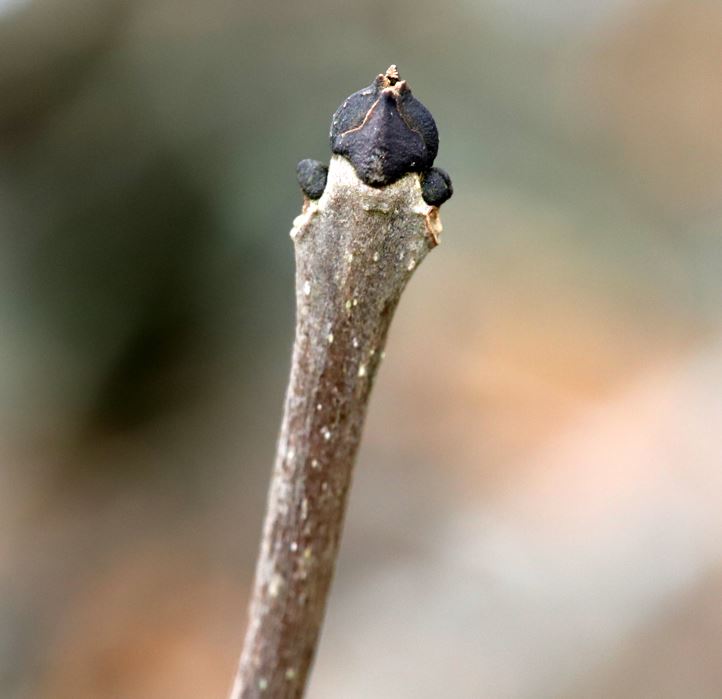To celebrate National Tree Week, botanist, Bill Burlton, shares the best way to identify trees this winter.
The classic way of identifying deciduous broadleaved trees in winter is by looking in detail at the twigs and winter buds. The size and colour of bud scales, the arrangement of buds on the twig and the colour, texture and presence or absence of hairs on the twigs are some of the clues that can guide you.
There are a lot of other clues that can help with identification. Bark – is it smooth, rough, corrugated, what colour is it, is it different on younger trees? Fruit – often fruits persist on trees during winter. These include acorns on Oak trees, Ash keys, Hazel nuts and cone like fruits of Alder. Leaves – leaves may persist on trees and they may help with identification. Be wary of leaves on the ground which may have been blown from other trees.
The form and location of some trees can also be a guide. For example, hazel is a small tree, often part of the ‘understory’ in a wood, and often multi-stemmed. Oak, Sycamore, Ash and Lime, when mature, are usually large, dominant trees. Alder is a medium sized tree that often grows along watercourses.

1. English Oak
Buds
Buds are brown, globose-ovoid, 1.5 times as long as wide and form a terminal cluster at the end of the twig. There are usually less than 20 bud scales. Lateral buds are arranged individually, irregularly, and roughly spirally around the twig.
Twigs
Grey brown and glabrous with irregularly spaced pale buff lenticels.
Bark
Smooth in young trees. Rugged and deeply fissured in mature trees sometimes with burrs, lumpy bark growths, on the trunk with small shoots sprouting from them.
Fruits
Acorn cups are on long stalks. Any remaining leaves are stalkless.
Please note that the buds of both our native species of oak, English, Pedunculate and Sessile Oak are very similar and not easy to tell apart.

2. Ash
Buds
Distinctive, black and velvety in texture. The terminal bud on each twig has been likened to a ‘Bishop’s mitre’ in shape and often has spreading bud scale tips. The lateral buds are ovoid-globose in shape.
Twigs
Pale grey-green to dark olive green with pale lenticels and ochre to brown semi-circular leaf scars.
Bark
On young trees bark is fairly smooth and light buff in colour. Older trees have grey, fissured bark.
Fruits
Often persist on the tree throughout the winter and hang in bunches. Each seed has a single wing attached.

3. Sycamore
Buds
Light green in colour with a single terminal bud, Lateral buds are arranged in alternate pairs along each twig.
Twigs
Grey brown with variable density. Pale, but prominent, lenticels.
Bark
Smooth light brown or grey in younger trees. Flaky in older trees often with a pinkish tinge in freshly exposed bark when flakes have come off.
Fruits
Hang in bunches with two seed and wings joined together form an upside-down V shape. Seeds often persist over winter.
Any leaves that persist on the tree will probably show the black circles of tar spot fungus which is very prominent on sycamore leaves.

4. Hazel
Buds
Ovoid, usually slightly flattened. Green to slightly reddish in colour. Few scales usually 7 -8. Bud scales have a slightly hairy edge but are otherwise glabrous.
Twigs
Grey-brown to olive grey. Fine brown hairs especially towards the top of the twig. Few lenticels that are more distinct on the lower part of each twig.
Bark
Burnished bronze when young and harsh to the touch. Older stems are pale brown with shallow flat ridges.
Fruits
Hazel nuts often persist on the trees into the winter.
Catkins, the male flowers, usually form in early winter and are a good diagnostic feature. They remain tightly packed until February or march when they open to allow pollen to disperse.

5. Common Alder
Buds
Purple. Stalked. Narrowly ovoid and Glabrous.
Twigs
Twigs are purple tinged with raised orange lenticels.
Bark
Bark is smooth and purplish brown in younger trees. Bark in older trees dark grey-brown and cracked into square plates.
Fruits
Common alder produces stalked cone-like fruits, 10 – 15mm long which persist on the tree over winter.
Male catkins form in late autumn and are visible on the tree throughout the winter.

6. Common Lime
Buds
Oval with 2, sometimes 3, bud scales. The lowest bud scale is only approximately half the height of the bud. Buds have been described as ‘looking like boxing gloves.’ Colour can vary from wine red to green, often greener when the bud is shaded.
Twigs
Green to red in colour. New growth has a distinct zig-zag growth pattern with the twig direction changing at each lateral bud.
Bark
Smooth pale grey-brown in young trees becoming irregularly ridged in older trees. A common feature is large numbers of small shoots that completely surround the trunk.
Fruits
The spherical fruits that hang in bunches of 4 or 5 drop off the tree and are not a guide for winter identification.
This is a widely planted hybrid between the two native limes, large leaved lime and small leaved lime. It is variable in its characteristics
If you are interested in finding out what’s what this winter, visit your local woodland or Gosforth Nature Reserve.